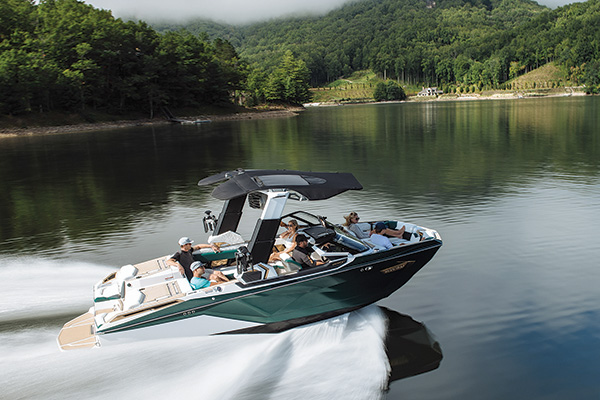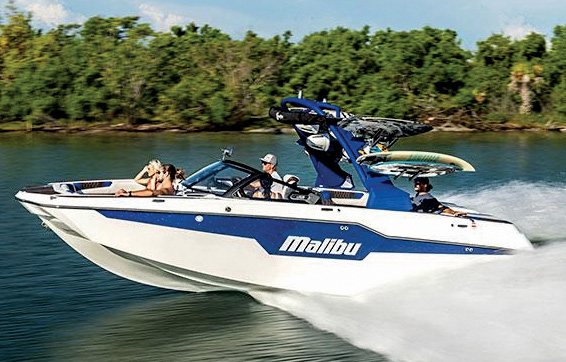Surf’s Up

By David Gee
Up. That’s about the only direction the towboat segment has known for some time, give or take a few tough months. Bigger boats. Heavier boats. Boats with more ballast. Boats with more features. Higher price tags. And more sales.
And 2020 continued that trend. For a short while anyway.
Malibu Boats, for example, reported in February that Q2 2020 net sales had increased 8.6% compared to the second quarter of fiscal year 2019, net income increased 17.3% while gross profit increased 4.1%.
“Initial feedback from January boat shows supports our belief of continued healthy market conditions and underscored the strength of our model year 2020 products,” commented Jack Springer, chief executive officer of Malibu Boats Inc., in a February earnings call.
Then March happened, with ski/wake boat registrations declining 16% YoY for the month and now standing 3% lower year to date, according to Michael A. Swartz, industry analyst at SunTrust Robinson Humphrey in Atlanta.
He said that marked just the third monthly YoY decline for the category over the past 12 months, although he acknowledged that it was up against a double-digit growth comparison versus the prior year period.
So how does this towboat downturn compare to the last big recession?
“During the last recession we did see a larger downturn relative to the overall industry, in terms of peak-to-trough volume decline, with a corresponding rebound that was also sharper than the rest of the industry,” Swartz told Boating Industry. “Interestingly the ski/wake category went into the downturn almost a full year after the broader industry. Perhaps it’s because the average towboat consumer is better able to withstand an economic contraction – at least early on – but that’s just conjecture. Certainly, there are a lot of small business owners who are buyers of these boats and you’re not exactly thinking about the pulling the trigger when you’ve been getting checks from the government and/or laying your staff off.”
Popularity contest
The ski and wake sport boat category had a lot of success attracting buyers from other segments, such as sterndrives, over the past eight to 10 years.
That’s been driven at least in part by the rapid innovation and the technology in the segment relative to the broader boat industry. Manufacturers in this segment utilized new wave-shaping technologies, touchscreen dashes and other features that made the boats produce bigger waves and wakes and easier to operate.
“Wake surfing has really taken over the industry,” says Bill Yeargin, president and CEO of Correct Craft. “Inside of 10 years ago very few people were doing it, it was pretty much unknown to the vast majority of boaters, and today it seems like everyone’s doing it. A high percentage of our boats are sold for the express purpose of wake surfing. People still water ski and wake board and even wake skate, but surfing is the big thing.”
It may seem like an obvious question, and I knew the answer, but I asked Yeargin why wake surfing became so popular anyway.
“It’s just plain fun,” he responded immediately. “And easy to learn. I have taught lots of people that had never done it before how to wake surf behind my boat. It’s also very low impact. You’re only going about 10 miles per hour and you have a big, cushy wave back there, so when you fall you just get wet.”
Sticker shock

One thing that hasn’t fallen is the cost of the boats. As ballast and surf systems get better, bigger and more sophisticated, cockpits become more complex, and the whole boats just gets more tricked out, the MSRP goes up accordingly.
“We discuss this all the time,” Yeargin told me, as we were standing in front of a Super Air Nautique G23 Paragon. “Let’s take the example of the Paragon. We simply set out to build the best wake boat we possibly could. And we knew it was going to be expensive and of course we were concerned about that. But we built it, and right away we ended up with more orders than we could fulfill. The truth is people want the amenities, they want the features, they want the great performance and high-end audio and the build quality. There is a cost to that. We can’t provide all those things inexpensively, as much as we would like to.”
“Just looking at pricing, in and of itself, is not overly telling since consumers are really dictating the final prices with options and upgrades that can add tens of thousands of dollars in additional costs,” opined Swartz, who follows the boating industry on a daily basis. “That said, I also don’t think this is a category where you will see people de-contenting just to be able to afford the monthly payment during a recession. If they are going in, they are going ALL in.”
New for 2020

So let’s take a look at some of that high-priced content.
For starters, how about the 2020 G23 Paragon that Yeargin mentioned? It features a 12.4” LINC Panoray interactive touchscreen, allowing the driver to easily change settings and make adjustments on the fly. It also has a telescoping tower, an integrated connectivity platform allowing owners to remotely view their boat’s fuel level, location, and battery voltage, and it’s powered by the PCM ZZ8. The engine platform, one of the most powerful ever offered from General Motors, is both direct injected and supercharged boasting 600 horsepower and 608 foot-pounds of torque. The boat weighs in at 7,200 pounds dry, and has an MSRP of $265,128.
And if those numbers aren’t big enough for you, Nautique now has the G23 Paragon’s big brother, the G25 Paragon. Coming in at 25-feet in length, with a 102-inch beam, the 7,400-pound boat is rated for 19 people and comes with an MSRP of $280,950.

Malibu also went big with their all-new M240. The 24-footer’s innovations start at the bow, with a new design for enhanced passenger comfort which includes a flip-up seat back that doubles as a wind block as well as additional forward seating. The all-new Malibu Command Center features ergonomic controls, and forward and rear-facing cameras to give the captain full situational awareness. The spacious lounge area has wireless charging stations that cut down on clutter and a premium Yeti cooler on rails.
Powering the M240 is the new Malibu Monsoon LT4 V8 direct injection engine. With 6.2 liters of displacement, 607 horsepower and 605 ft-lbs. of torque, this is the only supercharged inboard engine on the market to meet CARB’s four-star emissions rating.
And the High-Flow Malibu Launch System 6 (MLS6) ballast fills six tanks with up to 3,200 pounds of sub-floor ballast in less than three minutes.
MasterCraft completely redesigned their X26 for the 2020 model year, trying to bridge the gap they said between day cruisers and towboats without sacrificing performance for tow sport enthusiasts.

The boat utilizes MasterCraft’s Gen 2 Surf System and switchback ballast tank so the wave can be tailored to any rider, with even more comprehensive profiles. The X26 has a new transom seating design that allows for six rear facing seats to watch the wake action with the rear flip seat option, along with new under seat storage, a new port-side walk through and details like teak wood, premium stitching and a new helm design. The X26 also has a head, a truly rare feature for a towboat, as well as an optional refrigerator and cooler to aid all-day entertaining. And did we mention room for 18?
In terms of power, the X26, like all MasterCraft Boats, utilizes Ilmor Marine powerplants that are marinized exclusively for MasterCraft. Standard equipment on the X26 is the Ilmor 6.2L GDI series marine engine, the only gasoline marine engine with a five-star emissions rating. The GDI platform offers unparalleled fuel efficiency and an industry-leading 7-Year/1000-Hour factory-backed Standard Limited Warranty.
At the other end of the size spectrum, for 2020 Moomba came out with the Kaiyen; featuring the styling of last year’s successful Makai but in a smaller package at 21.5-feet.
“We take pride in each boat model we release, and every year we aim to step higher to exceed the market and customer expectations.” said Matt Brown, Skier’s Choice product development manager. “With the Kaiyen, we wanted to continue the momentum we gained from the home run we hit last year with the Makai.”
The boat features 3,700 pounds of standard ballast, along with a 7-inch dash display with wireless phone charging pad, a 15-person capacity, Raptor by Indmar 400 power and starting MSRP of $75,460.
For 2020 Tige Boats hit the GO button. The all-new GO System makes dialing in the boat effortless, automatically setting cruise control, ballast, and exclusive TAPS 3T surf plates for wake surfing, wakeboarding, skiing, or simply heading home.

It’s electric
And if you would like to do all those watersports activities without putting gas in your boat, Watershed Innovation (a subsidiary of Correct Craft) announced its newest brand, Ingenity, has an electric drive system powering a Nautique wake boat.
President of Watershed Innovation Sean Marrero said, “Electric is the propulsion of the future, but no battery in the world could meet the high-power requirements for a watersports boat, fit in the available space, and be used twice in the same day…so we designed our own.”
With 124 kWh of stored energy, the Ingenity battery allows for two to three hours of typical watersports use and can be recharged in as little as 90 minutes. The battery management system is designed for thousands of cycles which equates to many years of use powering a boat.
The future?

Lots of cool features and cool products. I asked industry analyst Michael Swartz if he thinks the towboat category will heat up again.
“I think this remains a growth category long-term given the increasing popularity of watersports, in general, and the ‘cool factor’ and innovation within the space,” he said. “This is and will continue to be a trade-over/trade-up boat that pulls from more traditional day boat categories.”
And though we won’t hold him to it, given the number of x factors and other unforeseen things in our future, I asked him for his overall boating industry prediction.
“In terms of participation, I think we could actually see a surge of interest later this summer if and when folks are freely able to get outside again and marinas are back to being fully operational,” Swartz said. “If you think about it, there’s an inherent social distancing element to boating in that you are with just a handful of people, at most, and you can drop anchor in the middle of a lake/ocean miles from the next human. With air travel and hotel-based vacations likely to be impacted for some time, I think boating is certainly one of the areas that could capture a greater piece of consumer leisure spending in the near term. How that translates to boat sales is likely more dependent on the health of the broader economy.”




